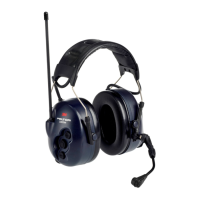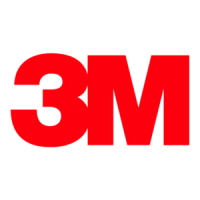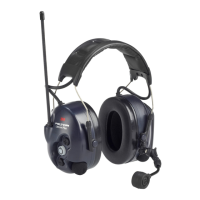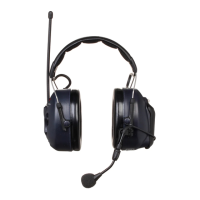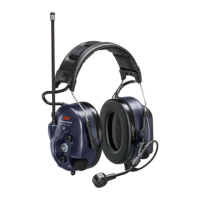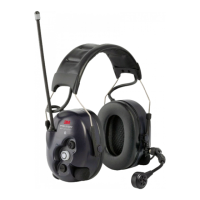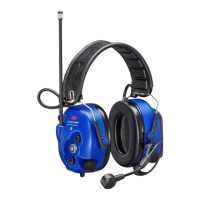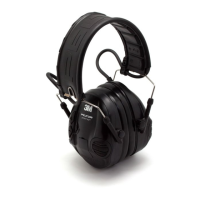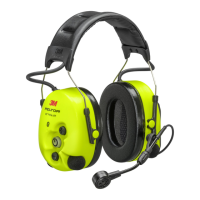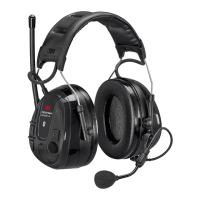2
and/or actual hearing protection obtained during exposure
to impulse noises. For gunre, the weapon type, number
of rounds red, proper selection, t and use of hearing
protection, proper care of hearing protection, and other
variables will impact performance. To learn more about
hearing protection for impulse noise, visit www.3M.com/
hearing.
• This earmuff is provided with electrical audio input.
The wearer should check correct operation before use. If
distortion or failure is detected, the wearer should refer to
the manufacturer’s advice.
• Operating temperature range: –20 °C (–4 °F) to 55 °C
(131 °F)
• Storage temperature range: –20 °C (–4 °F) to 55 °C
(131 °F)
APPROVALS
EU
Hereby, 3M Svenska AB declares that the radio com-
munication is in compliance with Directive 2014/53/EU and
other appropriate directives to fulll the requirements for
the CE marking. 3M Svenska AB also declares that the
PPE type headset is in compliance with Regulation (EU)
2016/425.
The PPE is audited annually and type approved by SGS
Fimko Ltd.Takomotie 8 FI-00380 Helsinki, Finland Notied
Body No. 0598.
The product has been tested and approved in accordance
with EN 352-1:2002/EN 352-3:2002, and EN352-6:2002.
GB
Hereby, 3M Svenska AB declares that the radio communi-
cation is in compliance with Radio Equipment Regulations
2017 and other appropriate regulations to fulll the require-
ments for the UKCA marking.
3M Svenska AB also declares that the PPE type hearing
protector is in compliance with Personal Protective Equip-
ment Regulations (Regulation 2016/425 as brought into UK
law and amended).
The PPE is audited annually, and type approved by SGS
United Kingdom Limited, Rossmore Business Park,
Ellesmere Port Cheshire CH65 3EN, UK, Approved Body
No. 0120. The product has been tested and approved
in accordance with EN 352-1:2002/EN 352-3:2002, and
EN352-6:2002.
EU and GB
The applicable legislation can be determined by reviewing
the Declaration of Conformity (DoC) at www.3M.com/pel-
tor/doc . The DoC will show if some other type-approvals
are also applicable. When retrieving your DoC, please
locate your part number. The part number of your earmuffs
can be found at the bottom of one cup. An example can be
seen in the picture below.
A copy of the DoC and additional information required
in the Regulations and Directives can also be obtained
by contacting 3M in the country of purchase. For contact
information, see last pages of this user instruction
This product contains electrical and electronic
components and must not be disposed of using standard
refuse collection. Please consult local directives for
disposal of electrical and electronic equipment.
LABORATORY ATTENUATION
The attenuation rating (SNR) was obtained with the device
powered off.
Explanation of the attenuation data (Table B)
European Standard EN 352
(B:1) Model designation
(B:2) Frequency (Hz)
(B:3) Mean attenuation (dB)
(B:4) Standard deviation (dB)
(B:5) Assumed Protection Value, APV
(B:6) Weight (g)
H = Hearing protection estimation for high frequency
sounds (ƒ ≥ 2000 Hz).
M = Hearing protection estimation for medium frequency
sounds (500 Hz < ƒ < 2000 Hz).
L = Hearing protection estimation for low frequency sounds
(ƒ ≤ 500 Hz).
(B:7) Criterion Level
H = Criterion level for high-frequency noise
M = Criterion level for medium-frequency noise
L = Criterion level for low-frequency noise
Compatible Industrial Safety Helmets (Table C)
These earmuffs should be tted to, and used only with, the
industrial safety helmets listed in Table C. These earmuffs
were tested in combination with the following industrial
safety helmets, and may give different levels of protection
if tted to different helmets.
Explanation of the industrial safety helmet attachment
table:
C:1 Helmet manufacturer
C:2 Helmet model
C:3 Helmet attachment
C:4 Head size: S = small, M = medium, L = large
EN
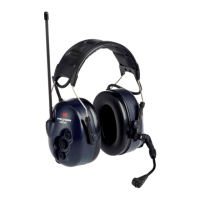
